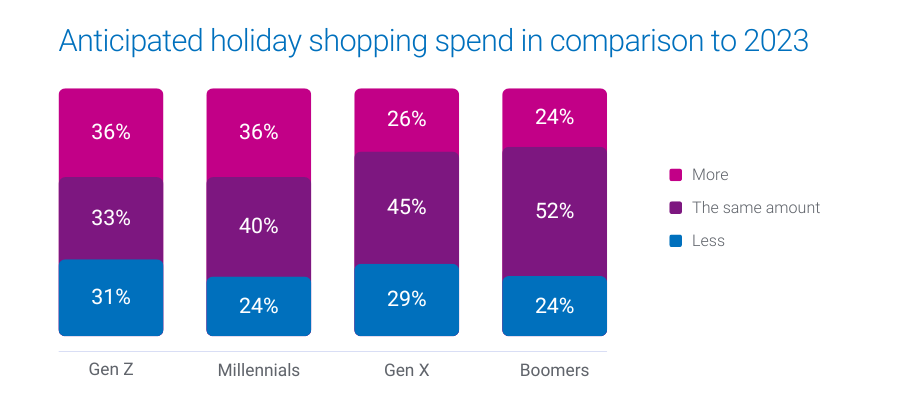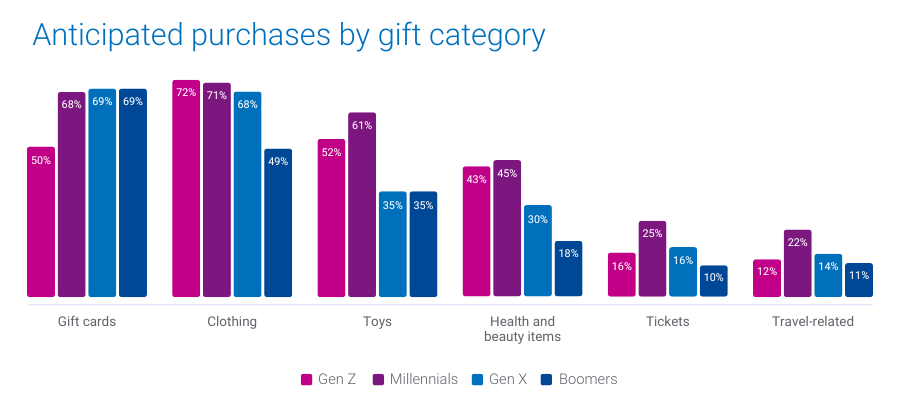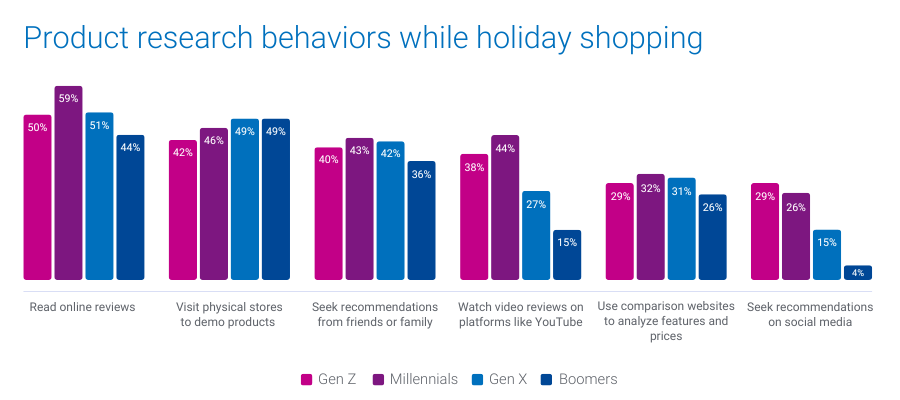
The holiday season is almost here, and knowing how each generation plans to shop can give your holiday advertising campaigns the edge you need. Our recent survey of 1,000 U.S. consumers reveals 2024 holiday shopping trends for each generation and key insights into their anticipated spending levels, preferred shopping categories, and how they look for gift ideas.
In this blog post, we’ll explore three 2024 holiday shopping trends across generations:
- Projected consumer spending
- Top categories on shoppers’ lists
- Preferred channels for researching gifts
1. Projected consumer spending
Over 1 in 3 Gen Z and Millennials are gearing up to increase their holiday budgets this year, while Gen X and Boomers are likelier to stick to last year’s budget.
- 36% of Millennials and Gen Z plan to spend more this holiday season
- 45% of Gen X and 52% of Boomers expect their spending to remain consistent with last year

What this means for marketers
These insights highlight the importance of tailoring your messaging. For Gen Z and Millennials, emphasize value and unique offerings that justify increased spending. For Gen X and Boomers, focus on trust and reliability, reinforcing their confidence in your brand.
How Experian can help you target these audiences
Experian’s custom and syndicated audience segments, including Holiday Shopper High Spenders and Holiday Shopper Moderate Spenders, enable you to connect with these diverse consumer groups. Our audiences are available on-the-shelf of leading ad platforms to help you reach people across social, TV, and mobile.
The election effect
U.S. holiday retail sales saw 4.1% YoY growth in 2016 and 8.3% YoY growth in 2020 following presidential elections. There’s a chance that holiday spending increases after the 2024 election, regardless of the outcome. Experian has 240+ politically relevant audiences that you can activate across major ad platforms ahead of the upcoming election.
2. Top categories on shoppers’ lists
Different generations have distinct preferences when it comes to what they plan to buy. Gift cards top the list for Gen X and Boomers, while Gen Z leans toward clothing. Millennials are looking to splurge on toys, electronics, and experiences.
- 69% of Boomers and Gen X plan to purchase gift cards
- 72% of Gen Z will buy clothing
- 45% of Millennials will buy health and beauty items
- 25% of Millennials will buy tickets and 22% of Millennials will buy experiences

What this means for marketers
Align your product offerings and promotions with each generation’s preferences to capture their attention. For example, highlighting versatile gift cards may resonate more with older generations, while showcasing trendy apparel and tech gadgets will appeal to younger consumers.
How Experian can help you target these shoppers
We offer audience segments like Holiday Shoppers: Apparel, Cosmetics & Beauty Spenders, and Toys Shoppers that you can activate to connect with consumers primed to purchase in these categories.
We recently released 19 new holiday shopping audiences we recommend targeting to drive engagement and conversions. Download our audience recommendations here.
3. Preferred channels for researching gift ideas
When it comes to finding the perfect gifts, Gen Z turns to social media, while Millennials prefer online reviews and video content. Boomers and Gen X are more inclined to visit physical stores for hands-on product evaluations.
- 29% of Gen Z and 26% of Millennials will look for gift ideas on social media
- 44% of Millennials will rely on video reviews and product demos on platforms like YouTube
- 49% of Gen X and Boomers plan to visit physical stores to evaluate products in person

What this means for marketers
Understanding where each generation looks for inspiration can guide your content and ad placement strategy. To engage Gen Z, focus on social media campaigns and influencer partnerships. For Millennials, consider investing in video content and reviews. For older generations, ensure your in-store experience is optimized to convert browsing into purchases.
How Experian can help you engage these shoppers
Our TrueTouchTM audiences can help you pair the perfect messaging styles with the right channels and calls to action. Our Social media channel and content engagement audiences can help you reach Gen Z who are likely to be active users on major social platforms and are Black Friday shoppers. For a full list of Experian’s syndicated audiences and activation destinations, download our syndicated audiences guide.
Download our report for five 2024 holiday shopping trends by generation
Understanding 2024 holiday shopping trends by generation can help you tailor your targeting, messaging, media planning, and creative based on the generation you’re targeting.
In addition to the insights covered here, download our 2024 Holiday spending trends and insights report to learn:
- When consumers plan to shop (hint: they’re already shopping)
- Where they plan to shop (online vs. in-store)
Download our full report to access all five of our predictions by generation, so you can address the diverse needs of this year’s holiday shoppers.
When you work with Experian for your holiday shopping campaigns, you’re getting:
- Accurate consumer insights: Better understand your customers’ behavioral and demographic attributes with our #1 ranked data covering the full U.S. population.
- Signal-agnostic identity solutions: Our deep understanding of people in the offline and digital worlds provides you with a persistent linkage of personally identifiable information (PII) data and digital IDs, ensuring you accurate cross-device targeting, addressability and measurement.
- Secure connectivity: Bring data and identity to life in a way that meets your needs by securely sharing data between partners, utilizing the integrations we have across the ecosystem, and using our marketing data in flexible ways.
Make the most of this holiday shopping season with Experian. Contact us today to get started.
Source
Online survey conducted in June, 2024 among n=1,000 U.S. adults 18+. Sample balanced to look like the general population on key demographics (age, gender, household income, ethnicity, and region).
Latest posts

As part of our ongoing series which focuses on consumer and marketing trends around major holidays throughout the year, we’ve just released the Father’s Day Hot Sheet. Father’s Day gift-related searches Now that Mother’s Day has come and gone, consumers will be shifting their focus to dad. According to Experian Marketing Services’ Hitwise® online intelligence tool, searches for “Father’s Day” typically start to pop up on Mother’s Day. And searches for “Father’s Day gifts” tend to focus on affordable gift ideas that are personalized, unique and often handmade. In fact, two of the top variations of Father’s Day gift-related searches from 2014 were for “DIY” and “homemade” gifts. While many shoppers wanted the “best” gift for dad, others simply wanted something “cheap” or “last minute.” Finding a gift that dad will appreciate means looking for something that is personalized to him. As such, searches for Father’s Day gifts often contain additional information about the dad or, in many cases, grandpa. Examples commonly used in 2014 were “Christian dad,” “new dads,” “outdoorsy dads” as well dads who are wine or BBQ lovers. While many gift searches include information about the intended recipient, others mention details about the gift-giver or their relationship to the father. Among last year’s variations that included such details, nearly a third focused on gifts that were intended to be given by a “daughter.” Genderless references, such as “kids” or “children” were almost as common. Interestingly, fewer than ten percent were for gifts to be given by a “son.” About a fifth of searches included details about the age of the gift-giver (e.g.: “baby,” “toddler” or “first grader”), while others specified that the gift was to be given by the dad’s wife or girlfriend. Go, go, gadget dad! Gadgets and gizmos are always popular gifts for the techie dad. In fact, during the week immediately preceding Father’s Day last year, visits to Electronics and Appliance websites were up a relative eight percent from two weeks prior. Visits subsequently tapered off the following week. An analysis of search terms driving traffic to the Hitwise Electronics and Appliance industry the week ending June 14 versus May 13, 2014 also sheds some light on the specific items that Father’s Day gift-givers were likely to have been seeking out. Two GPS systems (“Magellan GPS” and “Tom Tom”) were among the top terms that grew search share in the weeks leading into Father’s Day last year. Likewise, “GoPro” appeared in two separate fast growing search terms. Gadgets like these and others listed in the adjacent table may be big gifts for the gadget-loving dad again this year. Gone fishin’ Fishing is a timeless family pastime enjoyed by millions of Americans. According to Experian Marketing Services’ Simmons® National Consumer Study, 28 percent of dads and 26 percent of kids ages six to 17 went fishing last year. As such, it’s no surprise that online searches related to fishing spike over Father’s Day weekend. On the Saturday before Father’s Day in 2014, searches including “fishing” were a relative 28 percent higher than they were the Saturday prior and 64 percent higher than they were the following Saturday. To better understand what kids and dads were seeking out for their fishing plans, Experian Marketing Services conducted an analysis comparing variations of “fishing” searches immediately before Father’s Day last year to those performed two weeks prior. It turns out the word “techniques” was almost 8.6 times more likely to appear in fishing-related searches just before Father’s Day than it was two weeks earlier and “tips” was four times more likely to be used. Likewise, “licenses” was used 2.3 times more frequently, which along with the higher use of “techniques” and “tips” is evidence that many would-be fishermen and women are occasional participants at best. The fact that “charter” and “cabins” were used at higher rates however suggests that other children and/or dads had something in mind beyond a lazy (and likely more affordable) afternoon at the local fishing hole. Gift items, too, like “reels,” “gear” and “tackle” were among those most disproportionately used in searches heading into Father’s Day.

Welcome! Who doesn’t like a warm welcome? Whether your customer is walking into your store or just signed up on your website to receive communications from you, she expects a warm reception. It’s important to make that first impression count. A welcome series helps the conversation open up between the customer and your brand. It sets expectations on the types and cadence of content the customer will receive. Welcome emails also garner 86 percent higher open rates than regular promotional mailings – not too shabby! In a recent webinar, Saks Fifth Avenue shared that they are constantly testing new and current programs to optimize the customer experience. As a result, they discovered that switching from batch-sending welcome emails to sending welcome messages in real time increased open, click and redemption rates significantly. Here’s an example of their welcome series: Saks’ results are consistent with Experian Marketing Services’ welcome email findings which indicate that emails triggered in real time receive up to 10 times the transaction rates and revenue per email vs. those that are batched. A welcome series has also been shown to increase retention by educating customers on new ways to use products and services they’ve purchased from your brand. These emails also can remind customers of the benefits they’ll reap from enrolling in your loyalty programs or credit card. … and welcome back Even if a customer has been welcomed and has interacted with your programs, a day may come when the customer goes silent. Reactivation campaigns are an effective way to get them to re-engage. Naturally, it’s important to target your dormant customers in a variety of channels so you can reach them more effectively. Maybe you’re wondering why I jumped from the warmth of a welcome series right into reality of needing a reactivation campaign. The reason? Marketers need to understand where a customer is in their lifecycle and come full circle with customers if they have parted ways. Marketers can pique the interest of a returning customer by telling them what’s new and reintroducing them to their brand. Carnival® Cruise Lines, for example, sends a welcome-back email that features the newest social networks, offers and deals its customers can take advantage of immediately. At the end of the day, customers expect to receive relevant and engaging messages throughout their entire relationship with a brand. Customer life cycle programs deliver just that. If you’re interested in learning more about welcome campaigns, waitlist/back-in-stock programs and other remarketing strategies, check out our webcast,

In a previous blog entry, Ordering sushi and a lesson in embracing the contextual marketing mindset, I showcased a fictitious scenario that required complex data point integration to pull off. These kinds of programs can seem overwhelming given the three barriers that many organizations face when embarking on their contextual marketing journey: Marketing sophistication A brand’s own conventional mindset and the programs that support it Actionable data Lack of clean and accurate data that prohibits real-time “on the fly” interactions Technology Disparate systems that are unable to link information across repositories, channels and interactions; inability to automate interactions in real-time Regardless of the barriers, there are ways you can show customers you’re listening and provide contextual messages without “boiling the ocean.” Take, for example, the recent viral blue/black vs white/gold dress debate. As the conversation spread throughout Facebook and Twitter, brands like Dunkin’ Donuts and Tide tweeted these contextual messages: The tweets did not go unnoticed as thousands of followers retweeted, commented and favorited these messages. The contextual elements used in these messages — channel preference and breaking/relevant news — are easily accessible to any brand. While the brands had to act swiftly, executing these messages circumvented the three barriers listed above. On the flip side, addressing the barriers can allow a brand to build more sophisticated, targeted contextual messages, as shown in the below example. Here, Experian Marketing Services and technology partner Movable Ink helped Finish Line deliver this sale announcement that adjusts based on the date and time the customer opens the email. The message remains relevant via a countdown clock during the run of the sale, a “warning” when it’s about to end and an alternative message after the sale ends — all of which ensures that the message is relevant regardless of when it’s opened by its intended recipient. And combining more contextual data points, such as location and stock, Finish Line includes the countdown, a local map to the customer’s nearest location and up-to-the-minute inventory of available sizes. Contextual marketing enables modern enterprises to engage in customer-centric conversations that — like any meaningful relationship — deepen across time and future points of engagement. This is particularly true in an era when consumers are overwhelmed by untargeted and disruptive marketing messages. By contrast, contextual marketing is designed to seamlessly and usefully merge into the customer’s daily activity. Want to know more and how to get started? Download the eBook From campaigns to context: Making the move to contextual marketing.